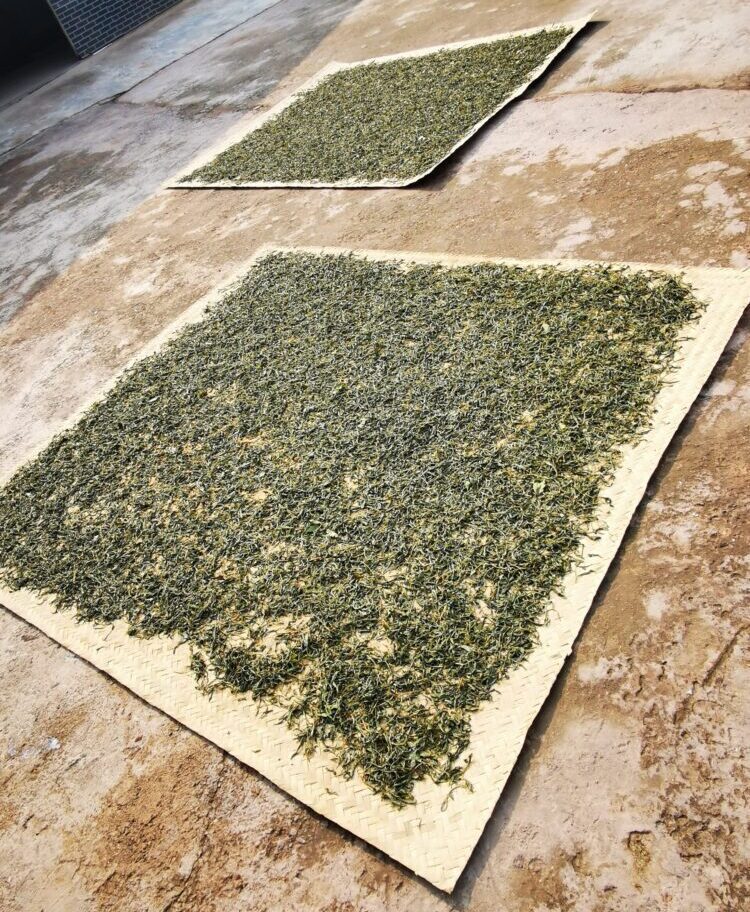Tea was a relatively late discovery in human history – for comparison, evidence of wheat cultivation as early as 10,000 years ago comes from the Fertile Crescent in Southwest Asia, between the Mediterranean and Caspian Seas. Nonetheless, tea has a long history. Said to have been discovered in 2737 B.C. in China, it was certainly being cultivated by the early part of the first millennium A.D.
There are 10th Century BC records of tea drinking in China and the Chinese philosopher Laozi (6-7thCentury BC), referred to tea as “the froth of the liquid jade”. Coffee cultivation came rather later; only going back a millennia, and the earliest record of coffee drinking is from the 10th Century A.D.
Tea falls into two main varieties; Camellia sinensis var. assamica and Camellia sinensis var. Sinensis. Sinensis sinensis is widespread throughout southern China and is found as far north as Hunan and Shanxi. Sinensis Assamica is essentially found only in western China; Guangdong, Guangxi, Guizhou, Hainan, Yunnan and neighboring countries – Burma, Laos, Thailand, Vietnam – but can also be found as far away as Madagascar.
Two other varietes of Sinensis – sinensis var. pubilimba and sinensis var. Dehungensis are found only in Western China and Yunnan respectively.
And What Makes it Puer?
The Yunnan Provincial Government has ruled that Puer tea* is defined by three criteria;
i) be of the broad leaf varietal (Da Ye / Sinensis Assamica)
ii) be grown in the Lancang/澜沧河 (Mekong、湄公河) River Basin Region
iii) be made from sun-dried mao cha.
Furthermore, the stipulation is that the tea must be wholly processed within the Lancang area. The method of making tea is largely the same for all types of tea, with some minor variations. Both raw or sheng Puer/生茶 and cooked or shou Puer/熟茶 start out in the same way. A common difference is also that cooked Puer is infrequently made from ancient or old tea tree leaves. Single mountain source cooked Puer does not produce the best tea – a blend of maybe 4-5 different mountains creates a better, more rounded tea. The maocha from which Puer is produced is made in the manner described here: Making Puer maocha.

The Raw and The Cooked
There is currently no official distinction between ‘cooked’ and ‘raw’ Puer Tea – both qualify as ‘Puer’ – but the last point – ‘sun-dried’ is of some importance. In years past, oven drying, was not uncommon particularly in the rainy season. Even now, smaller outfits in comparatively remote areas typically have a wood fired drying oven which they may possibly use if the weather does not permit sun drying, or if they risk loosing tea that they have made a day or two before because it hasn’t dried sufficiently due to inclement weather. Oven drying lacks any strong historical basis.
What of course is understood also is that Puer is ‘后发酵/post-fermented‘. This is what makes it different from other teas and whilst the ‘fermenting’ process of ‘cooked’ tea may continue after it has been wet piled/渥堆, it’s going to change rather less than raw tea, so the ‘post-fermentation’ processes are different.
The Importance of Sun Drying
Apart from raw fruit and vegetables, sun-dried Puer is one of the most natural, least processed products that we might consume. If one can imagine going into the mountains and picking wild vegetables, fruit, etc. taking them home and baking them a little at a low temperature, then drying them outside in the sun (in Xishuangbanna, this takes place in one of China’s remarkably un-polluted, environments with no real industry nearby) and finally processing the crop in some way – slicing, or crushing say, then one has some idea of what goes into the making of loose Puer leaves (mao cha/毛茶). Inevitably, this minimal intervention – from tree to tea affects the final outcome – the flavour of the tea, the inherent properties of tea.
This regulation has some interesting implications for the Puer market; apart from the labour intensive nature of tea making – hand frying, rolling and sorting, which can all be mechanised – sun-drying has the potential to be a bottle-neck in the production process as most producers have a limited amount of space for sun drying.
More on Storage and Ageing
Another contentious area is that of ‘Wet Storage’ (cang fang/仓房 /shi cang cha/湿仓茶) – intentionally storing Puer in a place of very high/very high humidity to speed up the fermentation process) which is sometimes depicted as having a long history. Here in Xishuangbanna (sub-tropical) there appears to be no historical evidence of people storing tea in caves or underground in any systematic way in an attempt to hasten ageing. Indeed, there would seem to be little point in doing so since the ambient environment is already humid (around 80% in the wet season) and to store Puer tea in a wetter environment, particularly if there is not good air circulation, risks the tea going mouldy. In the end, this is perhaps a question of taste as there is a school of thought that this kind of cang wei/仓味 tea is a sought after beverage. There is a history of wet storage in Hong Kong and Guang Dong, but it seems likely that this can only be a few hundred years old at most and was perhaps found to be an effective way of ageing some of the early Puer that is talked about here. It seems unlikely to be a good way to age ‘shan tou/山头‘ Puer from single sources.
